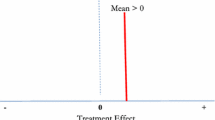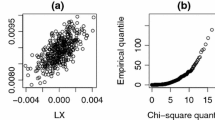Abstract
This paper builds upon two prior papers by Haviland and Nagin (Psychometrika 70:1–22, 2005) and Haviland, Nagin, and Rosenbaum (Working paper, 2006) that attempt to bring the key attributes of an experiment to the analysis of non-experimental longitudinal data. Using a case study of the facilitation effect of gang membership on violence, it systematically examines the contribution of group-based trajectory modeling to the achievement of covariate balance in observational data. In this case study, inclusion of the posterior probabilities of group membership (PPGM), from a model on the pre-treatment measures of the outcome variable, created closer balance on these key covariates than did analyses that did not include them. Still closer balance was obtained on these key covariates by stratifying the analysis by trajectory group. This stratification was achieved by fitting separate propensity score models and matching gang joiners to gang abstainers within trajectory group. In addition, we demonstrated that further balance could be obtained on additional covariates by including PPGM from a model on pre-treatment longitudinal data of these covariates. While this case study is only one empirical example, we believe that it provides useful empirical evidence on the value of performing within trajectory group causal inference in observational longitudinal data and on the use of the PPGM in achieving balance in propensity score-based causal inference.
Similar content being viewed by others
Notes
For discussion of the rationale for estimating the trajectory model over this age period see Haviland and Nagin (2005).
The original version of the question, as asked in French, was “Au cours des 12 derniers mois, as-tu fais partie d’un groupe de jeunes (gang) qui fait des mauvais coups?”
Variable matching is one of several possible methods for using propensity scores to create balanced treatment and control groups. It is not clear that other possible methods such as stratification and weighting would lead to different conclusions about the effect of trajectory group modeling on achieving balance, but that has not yet been determined.
The means for the controls are calculated by first calculating the mean of the matched controls for each joiner and then taking the average of these means.
In this case, due to the relatively small sample sizes, this criterion is more stringent than traditional significance levels for a t-test.
This match used the same variable matching rates for trajectory group 1 but increased the rate for trajectory group 2 to between 1 and 7 with an average of 5. Many versions of the stage 3 match were attempted before we settled on the final variable match rate. The results were comparable when the larger and smaller number of matches were used in group 2. At stage 4, the larger number of matches resulted in a more favorable match.
References
Bertsekas, D. P.(1981). A new algorithm for the assignment problem. Mathematical Programming, 21, 152–171.
Brennan, P. A., Grekin, E. R., & Snarnoff, S. A. (2003). In B. B. Lahey, T. E. Moffitt, & A. Caspi (Eds.), Causes of conduct disorder and delinquency. New York: Guilford.
Cochran, W. G. (1965). The planning of observational studies of human populations. Journal of the Royal Statistical Society, 128, 134–156.
Dorn, H. F. (1953). Philosophy of inferences from retrospective studies. American Journal of Public Health, 43, 677–683.
Elder, G. H., Jr. (1985). Perspectives on the life course. In: G. H. Elder, Jr. (Ed.), Life course dynamics. Ithaca: Cornell University Press.
Elder, G. H., Jr. (1998). The life course as developmental theory. Child Development, 69, 1–12.
Greenwood, P. W. (2005). Changing lives: Delinquency prevention as crime-control policy. Chicago: University of Chicago Press.
Haviland, A., & Nagin, D. S. (2005). Causal inference with group-based trajectory models. Psychometrika, 70, 1–22.
Haviland, A., Nagin, D. S., & Rosenbaum, P. R. (2006). Combining propensity score matching and group-based trajectory analysis in an observational study. Working paper.
Hawkins, J. D., Herrenkohl, T., Farrington, D. P., Brewer, D., Catalano, R. F., & Harachi, T. W. (2003). A review of predictors of youth violence. In R. Loeber & D. P. Farrington (Eds.), Serious & violent juvenile offenders risk factors and successful interventions. Thousand Oaks, CA: Sage.
Jones, B. L., Nagin D., & Roeder K. (2001). A SAS procedure based on mixture models for estimating developmental trajectories. Sociological Research and Methods, 29, 374–393.
Karoly, L. A., Greenwood, P. W., Everingham, S. S., Hoube, J., Kilburn, M. R., Rydell, C. P., et al. (1998). Investing in our children: What we know and don’t know about the costs and benefits of early childhood interventions. Santa Monica, CA: RAND.
Lacourse, E., Nagin, D., Vitaro, F., Claes, M., & Tremblay, R. E. (2003). Developmental trajectories of boys delinquent group membership and facilitation of violent behaviors during adolescence. Development and Psychopathology, 15, 183–197.
Laub, J., Nagin, D., & Sampson, R. (1998). Trajectories of change in criminal offending: Good marriages and the desistance process. American Sociological Review, 63, 225–239.
Laub, J. H., & Sampson, R. J. (2003). Shared beginnings, divergent lives delinquent boys to age 70. Cambridge, MA: Harvard University Press.
Li, Y. P., Propert, K. J., & Rosenbaum, P. R. (2001). Balanced risk set matching. Journal of the American Statistical Association, 96, 870–882.
Loeber, R., Farrington, D. P., & Waschbusch, D. A. (1998). Serious and violent juvenile offenders. In R. Loeber & D. P. Farrington (Eds.), Serious & violent juvenile offenders risk factors and successful interventions. Thousand Oaks, CA: Sage.
Ming, K., & Rosenbaum, P. R. (2000). Substantial gains in bias reduction from matching with variable numbers of controls. Biometrika, 56, 118–124.
Moffitt, T. E. (2003). Life-course-persistent and adolescent-limited antisocial behavior: A 1-year research review and a research agenda. In B. B. Lahey, T. E. Moffitt, & A. Caspi (Eds.), Causes of conduct disorder and delinquency. New York: Guilford.
Muthén, B. O. 2001. Second-generation structural equation modeling with a combination of categorical and continuous latent variables: New opportunities for latent class/latent curve modeling. In A. Sayers & L. Collins (Eds.), New methods for the analysis of change. Washington, DC: American Psychological Association.
Nagin, D. S. (1999). Analyzing developmental trajectories: A semi-parametric, group-based approach. Psychological Method, 4, 139–177.
Nagin, D. S. (2005). Group-based modeling of development. Cambridge, MA: Harvard University Press.
Nagin, D. S., Pagani, L. S., Tremblay, R. E., & Vitaro, F. (2003). Life course turning points: The effect of grade retention on physical aggression. Development and Psychopathology, 15, 343–361.
Olds, D. L., Henderson, C. R., Cole, R., Eckenrode, J., Kitzman, H., Luckey, D., et al. (1998). Long-term effects of nurse home visitation on children’s criminal and antisocial behavior: 15-year follow-up of a randomized controlled trial. Journal of the American Medical Association, 280, 1238–1244.
Pogarsky, G., Lizotte, A. J., & Thornberry, T. P. (2003). The delinquency of children born to young mothers: Results from the Rochester Youth Development Study. Criminology, 41, 101–138.
Robins, L. N. (1978). Sturdy childhood predictors of adult antisocial behavior: Replication from longitudinal studies. Psychological Medicine, 8, 611–622.
Rosenbaum, P. R. (1989). Optimal matching in observational studies. Journal of the American Statistical Association, 84, 1024–1032.
Rosenbaum, P. R. (2002). Observational studies (2nd edn.). New York: Springer-Verlag.
Rosenbaum, P., & Rubin, D. (1983). The central role of the propensity score in observational studies for causal effects. Biometrika, 70, 41–55.
Rosenbaum, P., & Rubin, D. (1984). Reducing bias in observational studies using subclassifications on the propensity score. Journal of the American Statistical Association, 79, 516–524.
Rosenbaum, P., & Rubin, D. (1985). Constructing a control group using multivariate match sampling methods that incorporate the propensity score. American Statistician, 39, 33–38.
Sampson, R. J., & Laub, J. H. (1993). Crime in the making: Pathways and turning points through life. Cambridge, MA: Harvard University Press.
Thornberry, T., Krohn, M., Lizotte, A., Smith, C., & Tobin, K. (2003). Gangs and delinquency in developmental perspective. Cambridge, UK: Cambridge University Press.
Tolan, P. H., & Gorman-Smith, D. (2003). Development of serious and violent offending careers. In R. Loeber & D. P. Farrington (Eds.), Serious & violent juvenile offenders risk factors and successful interventions. Thousand Oaks, CA: Sage.
Tremblay, R. E. (2003). Why socialization fails: The causes of chronic physical aggression. In B. B. Lahey, T. E. Moffitt, & A. Caspi (Eds.), Causes of conduct disorder and delinquency. New York: Guilford.
Tremblay, R. E., & Nagin, D. S. (2005). Aggression in humans. In R. E. Tremblay, W. W. Hartup, & J. Archer (Eds.), Developmental origins of aggression. New York: Guilford.
Tremblay, R. E., Desmarais-Gervais L., Gagnon C., & Charlebois P. (1987). The preschool behavior questionnaire: stability of its factor structure between culture, sexes, ages, and socioeconomic classes. International Journal of Behavioral Development, 10, 467–484.
Acknowledgments
The research was supported by the National Science Foundation (NSF) (SES-99113700) and the National Institute of Mental Health (RO1 MH65611-01A2). It also made heavy use of data collected with the support of Québec’s CQRS and FCAR funding agencies, Canada’s NHRDP and SSHRC funding agencies, and the Molson Foundation.
Author information
Authors and Affiliations
Corresponding author
Rights and permissions
About this article
Cite this article
Haviland, A.M., Nagin, D.S. Using group-based trajectory modeling in conjunction with propensity scores to improve balance. J Exp Criminol 3, 65–82 (2007). https://doi.org/10.1007/s11292-007-9023-3
Published:
Issue Date:
DOI: https://doi.org/10.1007/s11292-007-9023-3




